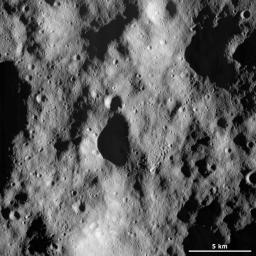This Dawn framing camera (FC) image of Vesta shows a part of the heavily cratered terrain in Vesta's northern hemisphere. There are a variety of craters in this image. They range from diameters of less than 1 kilometer (0.6 mile) to roughly 7 kilometers (4 miles). Some of the craters have fresh, sharp rims, which suggests that they are reasonably young. But most of the craters have degraded, rounded rims, which suggests that they are older. There is a cluster of small craters to the right of the center of the image. These craters may be secondary craters, which are formed by debris ejected out of larger impact craters during their formation. The northern hemisphere of Vesta contains more craters than the southern hemisphere, which indicates that the surface in the northern hemisphere is older than the surface in the southern hemisphere. This is because an older surface has more time to accumulate craters than a younger surface.
This image is located in Vesta's Bellicia quadrangle, in Vesta's northern hemisphere. NASA's Dawn spacecraft obtained this image with its framing camera on April 8, 2012. This image was taken through the camera's clear filter. The distance to the surface of Vesta is 219 kilometers (136 miles) and the image has a resolution of about 20 meters (66 feet) per pixel. This image was acquired during the LAMO (low-altitude mapping orbit) phase of the mission.
The Dawn mission to Vesta and Ceres is managed by NASA's Jet Propulsion Laboratory, a division of the California Institute of Technology in Pasadena, for NASA's Science Mission Directorate, Washington D.C. UCLA is responsible for overall Dawn mission science. The Dawn framing cameras have been developed and built under the leadership of the Max Planck Institute for Solar System Research, Katlenburg-Lindau, Germany, with significant contributions by DLR German Aerospace Center, Institute of Planetary Research, Berlin, and in coordination with the Institute of Computer and Communication Network Engineering, Braunschweig. The framing camera project is funded by the Max Planck Society, DLR, and NASA/JPL.
More information about Dawn is online at http://www.nasa.gov/dawn and http://dawn.jpl.nasa.gov.

 Planetary Data System
Planetary Data System












